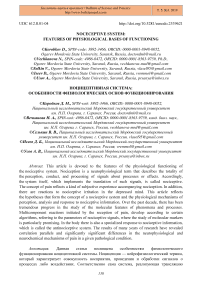Noceceptive system: features of physiological bases of functioning
Автор: Korobkov Denis, Vechkanova Natalia, Selkin V., Iseev D., Usov A.
Журнал: Бюллетень науки и практики @bulletennauki
Рубрика: Медицинские науки
Статья в выпуске: 1 т.5, 2019 года.
Бесплатный доступ
This article is devoted to the features of the physiological functioning of the nociceptive system. Nociception is a neurophysiological term that describes the totality of the perception, conduct, and processing of signals about processes or effects. Accordingly, the system itself, which implements the translation of such signals, is called nociceptive. The concept of pain reflects a kind of subjective experience accompanying nociception. In addition, there are reactions to nociceptive irritation in the depressed mind. This article reflects the hypotheses that form the concept of a nociceptive system and the physiological mechanisms of perception, analysis and response to nociceptive information. Over the past decade, there has been tremendous progress in the study of the molecular features of phenomena and processes. Multicomponent reactions initiated by the reception of pain, develop according to certain algorithms, referring to the parameters of nociceptive signals, where the study of molecular markers is particularly promising. In the body there is also a specialized response to nociceptive information, which is called the antinociceptive system. The results of many years of research have revealed correlation parallels and significantly significant differences in the neurophysiological and neurochemical mechanisms of pain in a given pathological condition.
Nociception, nociceptive system, physiological basis
Короткий адрес: https://sciup.org/14115013
IDR: 14115013 | УДК: 612.8.01-04 | DOI: 10.5281/zenodo.2539621
Список литературы Noceceptive system: features of physiological bases of functioning
- Baliki M. N., áVania Apkarian A. Nociception, pain, negative moods, and behavior selection//Neuron. 2015. V. 87. №3. P. 474-491.
- Baranauskas G., Nistri A. Sensitization of pain pathways in the spinal cord: cellular mechanisms//Progress in neurobiology. 1998. V. 54. №3. P. 349-365.
- Bufacchi R. J., Iannetti G. D. Gravitational cues modulate the shape of defensive peripersonal space//Current Biology. 2016. V. 26. №21. P. 1133-1134.
- Calvo M., Zhu N., Tsantoulas C., Ma Z., Grist J., Loeb J. A., Bennett D. L. Neuregulin-ErbB signaling promotes microglial proliferation and chemotaxis contributing to microgliosis and pain after peripheral nerve injury//Journal of Neuroscience. 2010. V. 30. №15. P. 5437-5450.
- Clark A. K., Yip P. K., Grist J., Gentry C., Staniland A. A., Marchand F., Dehvari M., Wotherspoon G., Winter J., Ullah J., Bevan S., Malcangio M. Inhibition of spinal microglial cathepsin S for the reversal of neuropathic pain//Proceedings of the National Academy of Sciences. 2007. V. 104. №25. P. 10655-10660.
- Ginhoux F., Lim, S., Hoeffel G., Low D., Huber T. Origin and differentiation of microglia//Frontiers in cellular neuroscience. 2013. V. 7. P. 45.
- Gómez-Nicola D., Valle-Argos B., Suardíaz M., Taylor J. S., Nieto-Sampedro M. Role of IL-15 in spinal cord and sciatic nerve after chronic constriction injury: regulation of macrophage and T-cell infiltration//Journal of neurochemistry. 2008. V. 107. №6. P. 1741-1752.
- Hackel D., Pflücke D., Neumann A., Viebahn J., Mousa S., Wischmeyer E., Roewer N., Brack A., Rittner H. L. The connection of monocytes and reactive oxygen species in pain//PloS one. 2013. V. 8. №5. P. 63564.
- Jackson P. L., Meltzoff A. N., Decety J. How do we perceive the pain of others? A window into the neural processes involved in empathy//Neuroimage. 2005. V. 24. №3. P. 771-779.
- Kawasaki Y., Xu Z. Z., Wang X., Park J. Y., Zhuang Z. Y., Tan P. H., Gao Y. J., Roy K., Corfas G., Lo E. H., Ji R. R. Distinct roles of matrix metalloproteases in the early-and late-phase development of neuropathic pain//Nature medicine. 2008. V. 14. №3. P. 331-336.
- Mansour A., Baria A. T., Tetreault P., Vachon-Presseau E., Chang P. C., Huang L., Apkarian A. V., Baliki M. N. Global disruption of degree rank order: a hallmark of chronic pain//Scientific reports. 2016. V. 6. P. 34853.
- DOI: 10.1038/srep34853
- Ren K., Dubner R. Interactions between the immune and nervous systems in pain//Nature medicine. 2010. V. 16. №11. P. 1267.


